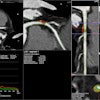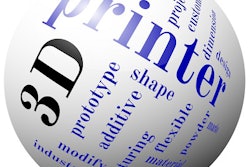
How can leaders in radiology prepare for the growing integration of 3D printing in clinical practice, and what measures can they take to help ensure its success? By investing more in radiologists' education and training in emerging technologies, according to one 3D printing expert from Florida.
Radiology is currently undergoing a "big-tech transition," and many companies are looking to tap into the specialty through new technologies, Summer Decker, PhD, told RSNA 2019 attendees at an educational session. Decker is the director of the 3D clinical applications division at the University of South Florida Department of Radiology.
 An individually tailored, multicolor 3D-printed heart. Image courtesy of Summer Decker, PhD.
An individually tailored, multicolor 3D-printed heart. Image courtesy of Summer Decker, PhD."As we go through this tech shift, we are actually finding new ways to make radiology valuable to other people in our hospital and our colleagues in other departments," she said. "Things like 3D printing, virtual and augmented reality, and artificial intelligence -- they are creating a value-added radiology for us."
One of the major challenges to adopting these technologies, however, is that many radiologists have not been trained in or exposed to them, whether due to their novelty or technical complexity, or simply a lack of time, Decker continued.
For their part, Decker and colleagues have established a division within their institution's radiology department dedicated to clinical applications of various 3D imaging techniques. To prepare radiology to take the helm of medical 3D printing, they have provided training to the full spectrum of medical professionals, focusing especially on the following groups:
- Radiologists: The 3D clinical applications division has trained radiologists on how to use 3D printing technology and also on understanding the optimal scenarios in which to apply 3D printing. The team's focus has been to establish proper standards that could help manage the expectations of clinicians who order 3D-printed models. Physicians from various other departments, including neurosurgery, cardiology, and orthopedics, also have participated in the training.
- Radiology residents: Decker and colleagues have recently added dedicated curriculum on advanced visualization technologies and their clinical applications into daily resident conferences at their institution. A lot of residents want to get involved in simulating image-guided procedures -- such as hip aspiration and lumbar puncture -- on 3D-printed models that they helped design and build based on real patient cases, she noted.
- Medical students: Perhaps most remarkable is that the team has incorporated 3D printing education into the institution's medical school. Students in as early as their first year of medical school are taught how to examine, interpret, and segment gross anatomy on radiological images for eventual 3D printing. The school also offers a summer program for students interested in 3D printing and a rotation on 3D applications.
Thus far, the division has received mostly positive feedback from those who participated in their 3D printing training programs. A number of students and residents have specifically mentioned in their personal statements that their experience with 3D imaging technology contributed to their desire to pursue radiology.
"For the next generation of radiologists to be able to work on [3D printing], we have to train them," she said. "We have to get them to understand what we are doing and how it helps ... to train people not to be afraid of what the next technology is, and this is the way we can do that for future growth and future success."



















